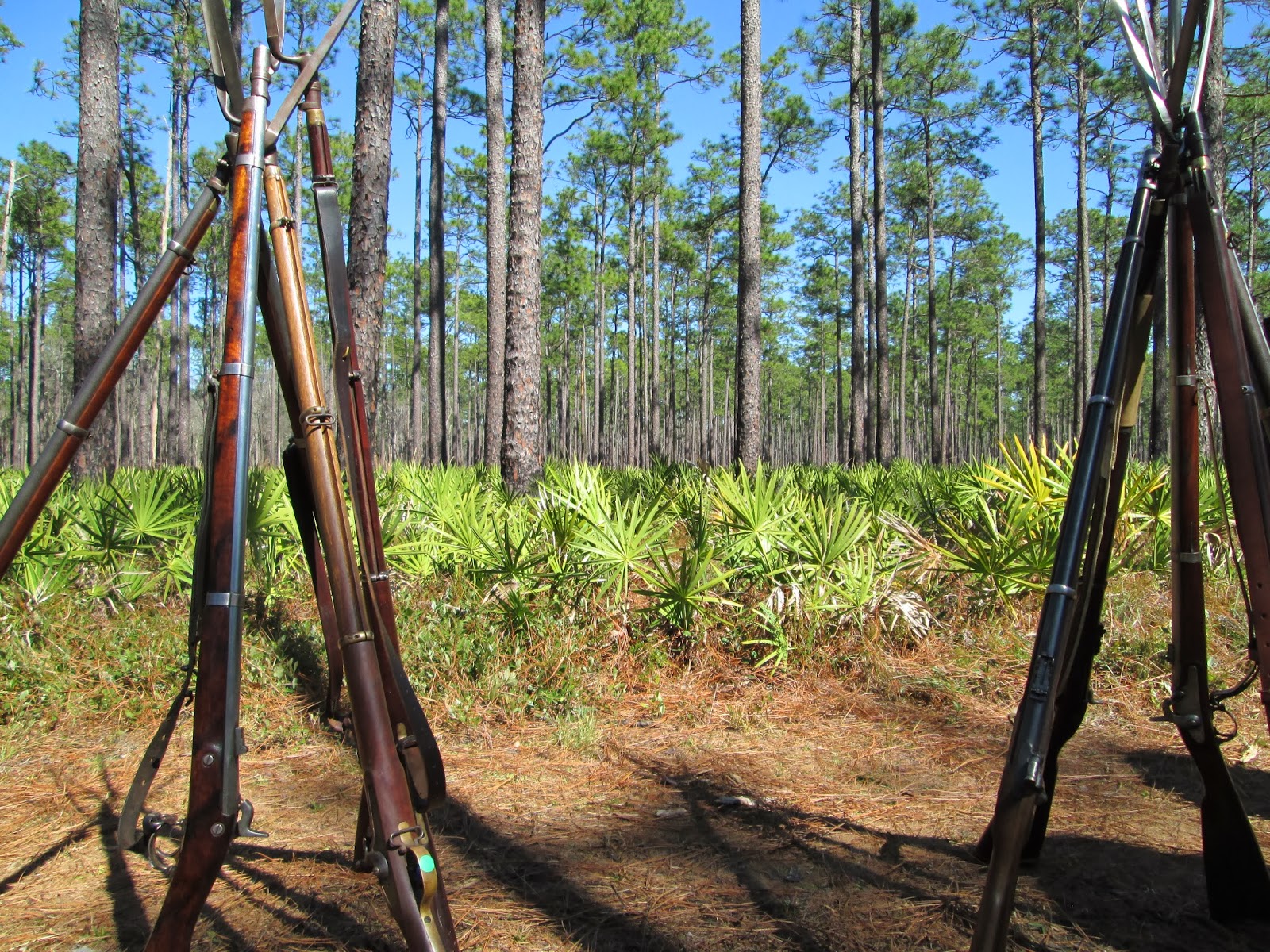150th Battle for Olustee
February 15-16, 2014
Sgt Jeff Carte, his wife Trish, and I packed together in our horseless SUV on our trek for reenactment during the worst part of winter. The ground was white and the weather maps showed that the worst part of the latest storm would be gone in North Carolina just as we passed through.
All seemed good. We made good time, leaving Thursday to take our time down and possibly enjoy some of the sights on the way.
 |
| Trouble with snow ahead |
Trish said, “Look at the bright side, at least we haven't had to wait as long as those in front of us.”
I responded that a couple of pennies out of a hundred dollars really doesn't make much of a difference.
But fortunately the National Guard arrived and somehow things cleared up. We passed the piles of snow. Past snowmen on the side of the highway, built by children looking to pass the time. Through the single lane of cleared highway.
We had planned to arrive at Olustee early Friday, but because of that delay we only managed to get there with just enough daylight to set our camp. The sun and warmth of Florida gave us hope for a good weekend. Temperatures reaching the 60s, and barely a cloud in the sky lifted our spirits from the winter depression. I made sure to send a text picture to Capt Sharp of every palm tree I could find.
The park was away from everything. The nearest town, Lake City, was a good fifteen minutes drive away. We have all done so many town events that Trish momentarily mistook the brightness from the moon for a streetlight—hoping the park would turn it off before we went to bed.
There was no other light beside the moon, the campfires, and candlelight. The forest of pines and brightness of the moon made it difficult to see any stars.
At morning reveille we fell in for roll call, followed by getting bused off to Lake City for the parade, where they served breakfast while we waited for the start. The walking of that parade was not a good start after having been away from activity since October.
 We fell in with the 3rd Florida, Co A. Capt Dennis Short has an interesting and effective method for recruiting for his company. The 3rd Florida brought sixty rifles to the field, which is significant for any company, even if it is a national event. What Capt Short does is to have special packages that he rents out with all the gear needed for the weekend. This has the benefit of giving people a chance to try out the hobby without dumping any real expense up front. The catch is that about a third of our company had never been in battle before—all fresh fish. It was a different experience, and it made me miss the 1st Tennessee, which is made up primarily of veterans.
We fell in with the 3rd Florida, Co A. Capt Dennis Short has an interesting and effective method for recruiting for his company. The 3rd Florida brought sixty rifles to the field, which is significant for any company, even if it is a national event. What Capt Short does is to have special packages that he rents out with all the gear needed for the weekend. This has the benefit of giving people a chance to try out the hobby without dumping any real expense up front. The catch is that about a third of our company had never been in battle before—all fresh fish. It was a different experience, and it made me miss the 1st Tennessee, which is made up primarily of veterans.The Saturday battle was short the needed number of Yankees, so the entire 3rd Florida galvanized. Sgt Carte had no Yankee gear, so had to borrow a kepi and coat. Unfortunately there weren't any trousers to spare, so he went out with his white and blue pillow tickling cotton.
We marched out to the battlefield. It was a long walk. Several miles passed, and by the end of it I began to realize how bad my boots were. The pain I felt left me barely able to walk.
Pushing through the pain, we pushed into battle. At one point, the inexperience of the troops became an abundance of confusion. The colonel ordered a change of fronts—whereby the battalion would basically turn ninety degrees to the right. The maneuver calls for each company to perform a wheel.
Capt Short ordered, “Right half-wheel, MARCH”, and immediately Chaos Theory proved a reality. Jeff and I, and a few others (including Capt John Fross of the 4th Texas, here as a private) were left behind while the rest of the company marched in random directions at varying paces. The words I shouted were, “Hey, where is everyone going?”
As chaotic as it was, Capt Short did a good job of regaining control and getting us roughly where we needed to be. I'm not sure many captains would have the patience he had in the situation.
We marched back to camp, with me hobbling the entire way, struggling to keep in step. My feet were suffering—I had no choice but to replace my ill-fitting boots with a new pair. My fortune was that a pair I had been eyeing at Rum Creek were still available.
At least Sunday had no parade. My feet improved and the new boots making a definitive difference, I still hobbled my way around. Morning held a memorial, with most of the morning free for breakfast.
When we formed up for the battle, this time in a proper gray, chants of “Sword” were heard. The entire battalion chanted it until an old general came forward with a sword, marching down the entire length of the battalion as he held it up.
The story was that this general was at the 125th Gettysburg. A Yankee tried to take his company's flag. The general used the sword to punch that Yankee and protect the flag, and the story has become legend with these Confederates. Apparently, they hold this ceremony with the sword every year.
The battle went well, but did not last long for me. I took a hit about halfway. With my feet they way they were, I kept my cap ration down, and went down when I ran out.
Back in camp the Cartes and I took a moment to relax to a pineapple while everyone else packed up. Worn out, I think both Jeff and I realize we need to work out a bit more before the next event. We both ached.
There was a bit of sadness at having to leave the sunshine and warmth of Florida into the grey and cold of the north.



